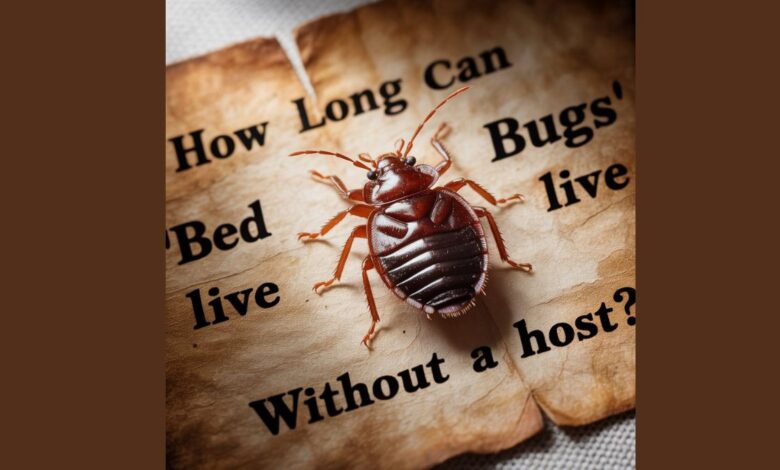How Long Can Bed Bugs Live Without a Host?

Have you ever asked yourself this question: How Long Can Bed Bugs Live Without a Host? and what happens to them when a property is unfurnished several months in a row? The idea is horrifying: those little critters unnoticeably roam around and await their next snack. Here in this publication we shall examine their periods of survival, the biology which helps them to have such a survival time especially, environmental factors and implications on you as far as prevention and control is concerned on pests.
Understanding Bed Bug Survival Without a Host
1. What Influences Their Lifespan Without a Blood Meal?
A number of factors are key determiners of the length of survival period that the bed bugs can go without taking a meal:
- Life stage: Adults will last a lot longer than nymphs. Adult bed bugs may exit lifespan up to several months, juveniles last only several weeks, deprived of a meal.
- Temperature: Lower temperatures reduce their metabolism, which can make them survive to up to one year.
- Humidity: The high humidity enables prevention of desiccation- the dry conditions speed up death .
- Microhabitats: Cristal places: Mattresses, crannies, behind baseboards provide shelter and help them to survive.
2. Typical Survival Times: By the Numbers
| Life Stage | Survival Without Host | Conditions |
|---|---|---|
| Nymphs (young) | ~2–6 weeks | Room temperature |
| Older nymphs | ~1–2 months | Moderate environments |
| Adults | 4–6 months | Room temp, decent humidity |
| Chief cases | Up to ~400 days (~13 months) | Cooler temps, semi-dormancy |
| Lab extremes | Over 1 year | Highly controlled studies |
- Adults at room temperature ( approx. 70 0 F ) die within 456 months, possibly approaching 365 days with cooler temperatures.
- Studies have demonstrated that grown-up starved adults had to survive on 135 to 300 days deprived of food.
- In one study survival is up to ~400 days with ideal dormancy conditions.
3. Why These Numbers Matter: Implications for Homes & Vacancies
- Empty houses are not safe havens: Bedbugs are capable of patience, with the time-between-tenancy gap to be solved until new occupants move in. Another claim shows 4 1/2 months survival in vacant houses.
- Bite schedule: The female male has the capacity to produce eggs despite a prolonged period of no food since its feeding cycle lasts 510 days of the year.
- Low-temperature measures (starvation tactics) do not always work out; they can live inside the crevices a year or two.
4. Dormancy & Metabolism: The Hidden Survival Powers
- In order to conserve energy, bed bugs initiate the process of diapause/hibernation where their metabolism will be suppressed drastically.
- Then below 16 C (60 F) these adaptations take effect and they become ultra-tough .
- Risk of desiccation: In humid conditions, they die due to water loss more rapidly than due to starvation humid conditions to survive 50 days at room conditions.
5. Can They Eat Pets or Rodents? Alternative Hosts
- How Long Can Bed Bugs Live Without a Host? Although the bed bugs prefer to bite human beings, they will bite rodents, birds and pets, in case there are no human beings.
- It enables them to survive in the empty houses where there are animals.
6. Effective Eradication & Prevention Strategies
Heat Treatment
- Prolonged temperatures of 113 F (45 C) in 90+ minutes kill all stages professionally.
Cold Treatment
- Causes death by freezing at -12o C (10o F) after a period of a few days.
Vacuuming & Steam
- Adults and eggs die rapidly at steam cleaners at above 230 deg F.
Mattress Encasements
- Feeding adults are trapped in encasements and starve in a few months.
Chemicals & Integrated Pest Management
- Heat, steam, encasement and vacuum represent non-chemical approaches, which are the safest. Combined pesticides and desiccants approved by EPA are used when they are required.
- The bed bugs are highly resistance to most of the insecticides thus there is need to use integrated strategies.
7. Summing Up: What You Need to Know
- Adults are livable anywhere between 4 6 months, and even 400+ days in the ideal dormancy condition.
- Nymphs survive weeks to no more than ~2 months without feeding.
- Evicting a space and leaving bed bugs to starve to death is not really a viable strategy as bugs have the capacity to outlive a person.
- To eradicate completely the use of comprehensive tactics is necessary; heat, cold, steam, encasements, inspection, and chemical treatments.
- Control measures post-remediation such as clean travel practice and monitoring are important.
8. Final Takeaways: Your Action Plan
- Feeling is not the solution at all; bed bugs can settle down comfortably in vacant places within one and a half years.
- Apply effective techniques of treatment heat treatments, exposures to the freezer, steam vacuums and encasings.
- Think numb to get together the non-chemical and chemical ways of doing things and particularly so in case of taking professional assistance.
- Be alert- luggage, secondhand goods, and ensure for sealed furniture must be avoided as they may be reintroduced.
In Closing
How Long Can Bed Bugs Live Without a Host? Bed bugs are adverse survivalists. Adults may even remain a year without any host at all, waiting out of cracks and crevices until warmth re-appears. The most effective weapon you have is knowledge: you have to know their boundaries and merge clever eradication methods so that you win in the struggle against these stubborn pests.



